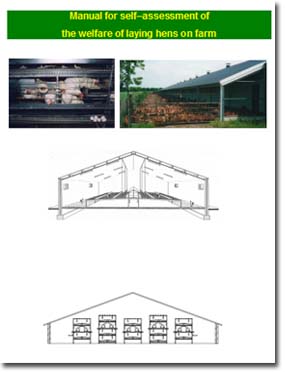Manual
Introduction to the welfare of laying hens
 We shall first consider some basic questions about hen welfare and its assessment on farms and then describe the more popular systems of housing for laying hens. This section also looks at some of the strengths and weaknesses of conventional cage, furnished cage and non-cage systems in terms of bird welfare. This will help you to find out where the risks for bird welfare are in your system. Remember each flock and each farm is unique and welfare problems may also vary from day to day.
We shall first consider some basic questions about hen welfare and its assessment on farms and then describe the more popular systems of housing for laying hens. This section also looks at some of the strengths and weaknesses of conventional cage, furnished cage and non-cage systems in terms of bird welfare. This will help you to find out where the risks for bird welfare are in your system. Remember each flock and each farm is unique and welfare problems may also vary from day to day.
What is welfare?
In simple terms, welfare means well-being. In considering hen welfare we are asking ourselves how well is a hen coping in her environment? Is she healthy? Is she suffering?
The Treaty of Rome recognised all farm animals as being sentient and that means that we accept hens as being capable of feeling. Hens can process information in their brains and translate it into feelings. So they do not merely respond to hot and cold conditions like thermostats but actually feel hot or cold. They respond to other situations with feelings too. Scientists are still finding out more about how chickens’ brains work and we already know that hens are a lot more sophisticated than we used to think they were.
In practical terms we now have pretty good evidence that hens can also feel pain and emotions such as fear. They appear to be able to show preferences and choices and to indicate what their priorities are. For example, carefully designed experiments have shown that hens really feel strongly about having access to an enclosed nest for laying their eggs in – and they will work hard to reach a nest - even pushing to open weighted doors.
Why should we measure hen welfare?
It is increasingly accepted across not only Europe but also in other parts of the world that we have a moral as well as legal duty to ensure the well being or welfare of animals in our care, or which we use. Thus consumers who eat meat or animal products such as eggs are also becoming more concerned that food-producing animals experience good welfare throughout their life. Consumer concern for animal welfare has led to farm assurance schemes and has driven legislation, including the Council Directive 1999/74/EC that is set to ban the conventional battery cage.
So, continually monitoring the welfare of your hens in a structured way, and keeping records, not only makes sure that you the farmers and stock keepers focus on the well being of the birds you look after, but also gives evidence to assure consumers that you are doing so.
How is welfare assessed?
There are all sorts of ways, including quite complicated techniques that can only be conducted in research facilities. The important thing is for an assessment to consider a range of factors and for these to be bird-based where possible. To give an example of what we mean by bird-based, rather than measuring air temperature it is more relevant to look at the birds and see whether they are panting (feeling hot) or huddling together (feeling cold). In this manual we suggest a range of simple checks of health, body condition and hen behaviour that can give a good idea of how well your hens are coping with the conditions on your farm. Many of these checks have been validated by extensive research in specialised facilities. Of course it is also important to make sure that the basic provisions such as balanced feed, clean water and fresh air are also reaching the hens as planned.
Where is welfare assessed?
It is important for welfare to be measured throughout life wherever the bird is. So welfare should be regularly monitored right from the chick hatchery to the point of slaughter. This manual considers only the laying period on farm.
Who should assess hen welfare?
The most important people are those in daily contact with hens, with direct responsibility for their care. It is well recognised that good stockmanship is the key to good animal welfare and often more important than facilities.
Frequently those who assess hen welfare on farms are visitors from agencies or retailers. They go away with only a snapshot view of the welfare of hens on that farm.
This manual is for you who look after hens all the time to help record all the things you do routinely as part of being a good caring stock person. It may also introduce some new ideas about hen welfare and things to observe that could make management easier and improve the health and productivity of your hens. Good welfare often pays in more ways than one.
When should welfare be assessed?
Clearly a good stockperson considers welfare almost sub-consciously whenever they have contact with the hens. In this manual we suggest recording some checks daily and some less often.
| Description | download |
| 7.2 Manual that can be used to audit the welfare of laying hens at a farm level in whatever housing system they are held |